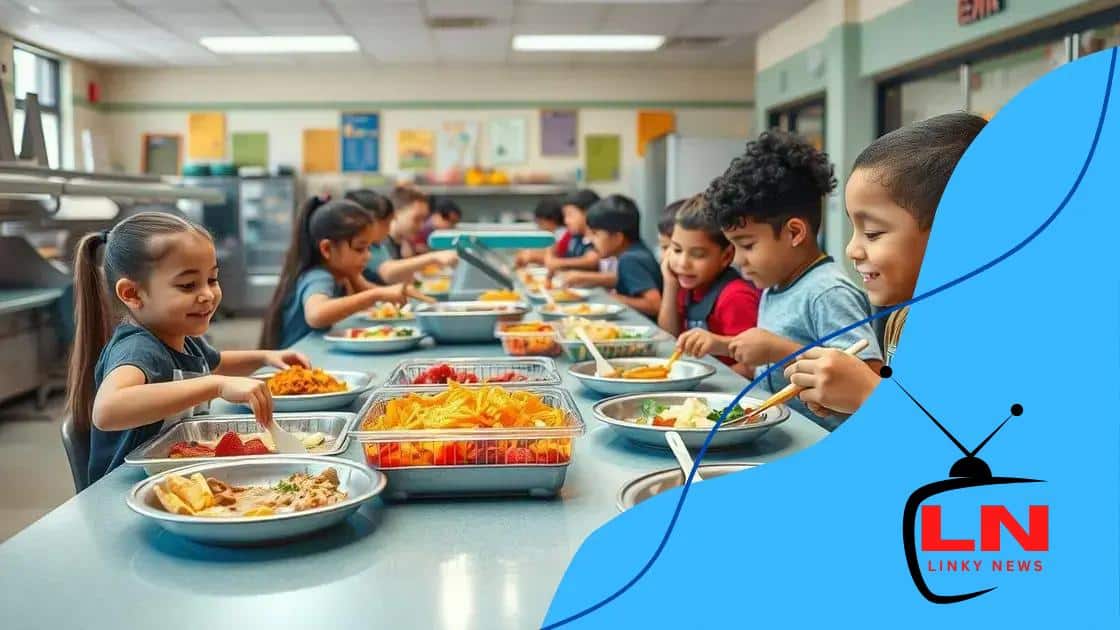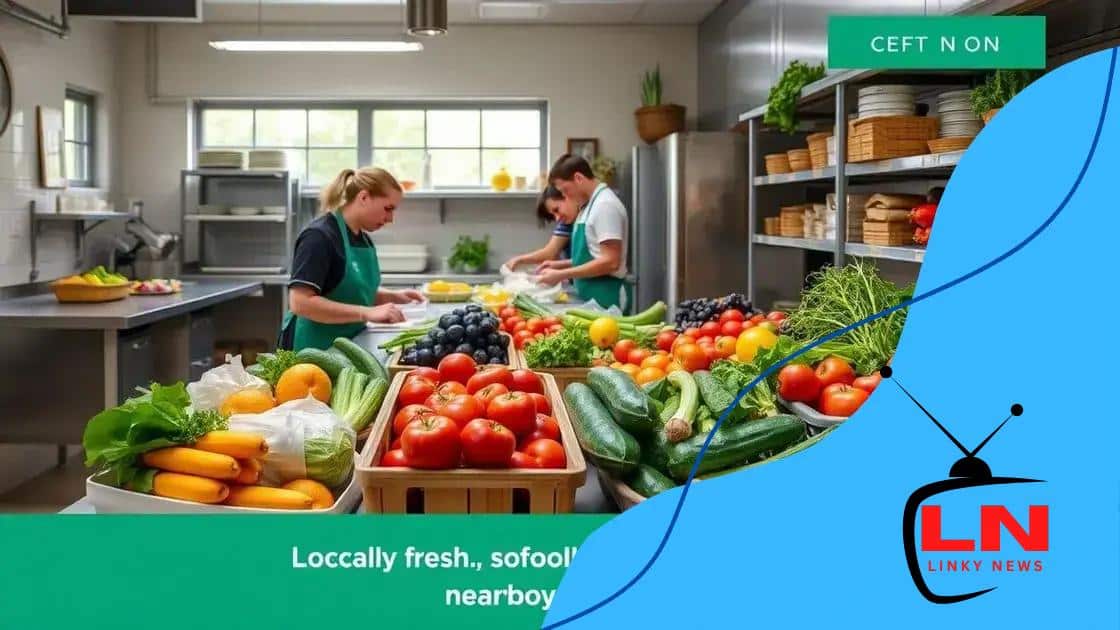Sustainable meals in school cafeterias: a winning solution

Sustainable meals in school cafeterias enhance student health and environmental awareness by using fresh, local ingredients, engaging students in meal choices, and promoting community involvement.
Sustainable meals in school cafeterias are more than just a trend; they’re a vital step toward healthier eating habits for our children. Have you ever wondered how schools can turn their lunch programs into something truly beneficial for students and the environment? Let’s delve into it.
Understanding sustainable meals
Understanding sustainable meals is crucial in today’s world. Schools have the unique opportunity to teach children about healthy eating and environmental care through their meal programs.
At the heart of sustainable meals is the idea of using fresh, local ingredients. This not only ensures that food is nutritious, but it also helps reduce the carbon footprint. Schools can support local farms, which strengthens the community and enhances the quality of the food served.
Key Principles of Sustainable Meals
Incorporating sustainable meals involves understanding several important principles:
- Utilizing organic ingredients whenever possible enhances health benefits.
- Minimizing processed foods helps maintain the nutritional value.
- Implementing seasonal menus allows for fresh produce and variety.
- Encouraging plant-based options promotes health and sustainability.
When schools source food locally, it not only tastes better but also educates students about where their food comes from. This practice fosters appreciation and respect for food. By learning to value fresh produce, children will likely carry these habits into adulthood.
Moreover, providing a variety of meals encourages students to try new foods. This experimentation can lead to healthier eating patterns. Schools should make meals colorful and appealing, showing students that healthy food can be fun!
Benefits of Sustainable Meals
The benefits of implementing sustainable meals are substantial. Not only do they promote better health among students, but they also help the environment. Using local ingredients reduces transportation emissions, which is a small yet significant step towards combating climate change.
Encouraging sustainable eating practices in schools lays the groundwork for lifelong healthy habits. Children who learn about nutrition and sustainable agriculture are more likely to make informed choices as adults.
In summary, promoting sustainable meals in school cafeterias not only nurtures students’ minds and bodies, but it also contributes positively to the planet. Schools are in a pivotal position to lead this important change.
Benefits of sustainable meals for students
The benefits of sustainable meals for students are numerous and impactful. When schools provide meals that are not only healthy but also sustainable, they create a positive environment that promotes better learning and well-being.
One significant advantage of these meals is the improvement in student health. By focusing on fresh, local ingredients, schools can ensure that students receive nutritious meals that fuel their bodies and minds.
Nutritional Improvements
Meals made from whole, organic ingredients typically contain more vitamins and minerals. This can help students:
- Improve their concentration and focus in class.
- Boost their energy levels throughout the day.
- Enhance their overall immune system.
Moreover, sustainable meals often include a variety of fruits and vegetables, which can help develop a taste for healthy foods. Exposure to a range of flavors encourages students to make better food choices.
Environmental Awareness
Another important aspect is how sustainable meals teach students about the environment. By incorporating local and seasonal ingredients, schools can instill values of environmental responsibility in young minds. This education fosters a sense of connection to the community and nature.
When students see the direct impact of their food choices, they become more likely to support sustainable practices in their own lives. This may involve choosing local products or reducing food waste.
Additionally, focusing on sustainability often leads to less packaging waste. By using bulk foods and reusable containers, schools contribute to a cleaner environment.
Incorporating cultural diversity into meals can also enhance student engagement. Learning about different cuisines introduces students to various cultures, making lunchtime an educational experience.
The benefits of sustainable meals in school cafeterias extend beyond nutrition and environmental awareness. They play a crucial role in shaping students into informed eaters and conscious citizens. Encouraging and promoting such meals is essential for a healthier, more sustainable future.
How to source ingredients sustainably

How to source ingredients sustainably is a vital topic for schools looking to improve their meal programs. By focusing on sustainability, schools can positively impact both student health and the environment.
To start sourcing ingredients sustainably, schools should connect with local farmers. This not only ensures fresher produce but also supports the local economy. Building strong relationships with farmers can create opportunities for educational visits, enhancing students’ understanding of food sources.
Key Strategies for Sustainable Sourcing
Here are some effective strategies that schools can implement:
- Establish partnerships with local farms to ensure access to seasonal produce.
- Participate in community-supported agriculture (CSA) programs to receive fresh ingredients regularly.
- Prioritize organic products to reduce exposure to harmful chemicals.
- Consider purchasing directly from food cooperatives that promote sustainability.
In addition to sourcing local, schools should also focus on seasonality. Using seasonal ingredients means that meals will be fresher and more flavorful. This practice helps educate students about the food cycle, making them more aware of what’s in season and supporting a varied diet.
Reducing food waste is another critical factor in sustainable sourcing. Implementing a farm-to-table approach ensures that schools are buying only what they need and using ingredients efficiently. This method encourages creativity in the kitchen as chefs find ways to incorporate all parts of fruits and vegetables.
Educating Students About Sustainability
Including students in the sourcing process can also foster excitement about sustainable meals. Schools might organize field trips to farms or have guest speakers educate students about agriculture. Understanding the origins of their food can empower students to make healthier choices.
By embracing these practices, schools pave the way for a healthier future. Sourcing ingredients sustainably not only enhances the quality of meals but also ingrains appreciation for the environment and local communities in the students.
Examples of successful school cafeteria programs
There are many examples of successful school cafeteria programs that illustrate how schools can effectively implement sustainable meals. These programs not only improve student health but also create a supportive community environment.
One notable example is the program at the Greenfield School District, which focuses on farm-to-school practices. They partner with local farmers to provide fresh produce daily. This initiative boosts the quality of meals and teaches students about the origins of their food.
Key Features of Successful Programs
Successful school cafeteria programs typically have several key features:
- Engagement with local farms to secure fresh ingredients
- Nutrition education integrated into the curriculum
- Opportunities for students to participate in meal preparation
- Innovative menu designs that reflect cultural diversity
Another great model is the Santa Monica-Malibu Unified School District. Their approach includes a focus on whole, unprocessed foods and they’ve eliminated all sugary drinks from their cafeterias. This initiative has led to healthier lunch choices for students and a reduction in waste from containers.
In addition to improving nutrition, this program incorporates an educational component. Students regularly participate in hands-on activities, such as planting gardens and cooking classes, which enhances their understanding of health and nutrition.
Community Involvement
Community involvement is crucial for the success of these programs. The Chicago Public Schools have established a local food policy council that includes parents, administrators, and nutritionists. This collaboration ensures that the meals served meet the needs and preferences of the community.
Furthermore, some schools offer tasting events where students can try new foods. Gathering feedback from students encourages them to be part of the decision-making process, making them more likely to choose healthy options.
These successful school cafeteria programs demonstrate the importance of collaboration, education, and community support in creating sustainable meal options. Schools across the country can learn from these examples to improve their own cafeteria offerings.
Engaging students in meal choices
Engaging students in meal choices is essential for creating a successful school cafeteria program. When students feel involved, they are more likely to try new foods and make healthier choices.
One effective way to engage students is through student-led committees. These committees allow students to voice their opinions and preferences about the meals served. When students have a say, they become more invested in their food choices.
Interactive Taste Tests
Another great approach is to hold interactive taste tests. Schools can invite students to sample different dishes and provide feedback. This not only makes meals fun but also helps students develop their palates.
- Consider rotating themes, like “Cultural Food Days” to explore diverse cuisines.
- Offer rewards for participating in taste tests, such as stickers or small prizes.
- Use social media to encourage students to share their favorite meals and ideas.
Involving students in the decision-making process creates excitement. Schools can also use surveys to gather input about meal preferences. This feedback ensures that menus reflect what the students truly want to eat.
Cooking Classes and Workshops
Another engaging initiative is to conduct cooking classes or workshops. These sessions can teach students how to prepare fresh meals using the ingredients served in the cafeteria. Learning to cook helps students understand nutrition and encourages them to eat healthier.
Additionally, schools might consider incorporating educational elements about food waste and sustainability. Teaching students how to reduce waste can foster a sense of responsibility toward the environment.
Creating a school garden can also enhance student engagement. Students can grow vegetables and herbs that they later use in their meals. This hands-on experience connects them to food sources and promotes appreciation for fresh produce.
By implementing these strategies, schools can successfully engage students in their meal choices, transforming the cafeteria into a vibrant space that reflects the tastes and desires of the student body.
FAQ – Frequently Asked Questions about Sustainable Meals in School Cafeterias
What are sustainable meals?
Sustainable meals are prepared using fresh, local ingredients, focusing on minimizing environmental impact and promoting healthy eating.
How can students be involved in meal planning?
Students can participate through taste tests, surveys, and student-led committees that provide feedback on meal options.
Why is sourcing local ingredients important?
Sourcing local ingredients supports the local economy, provides fresher produce, and reduces the carbon footprint associated with transportation.
What are the benefits of sustainable meals for students?
Sustainable meals lead to better nutrition, improved health, and increased awareness of food origins and environmental responsibility.





